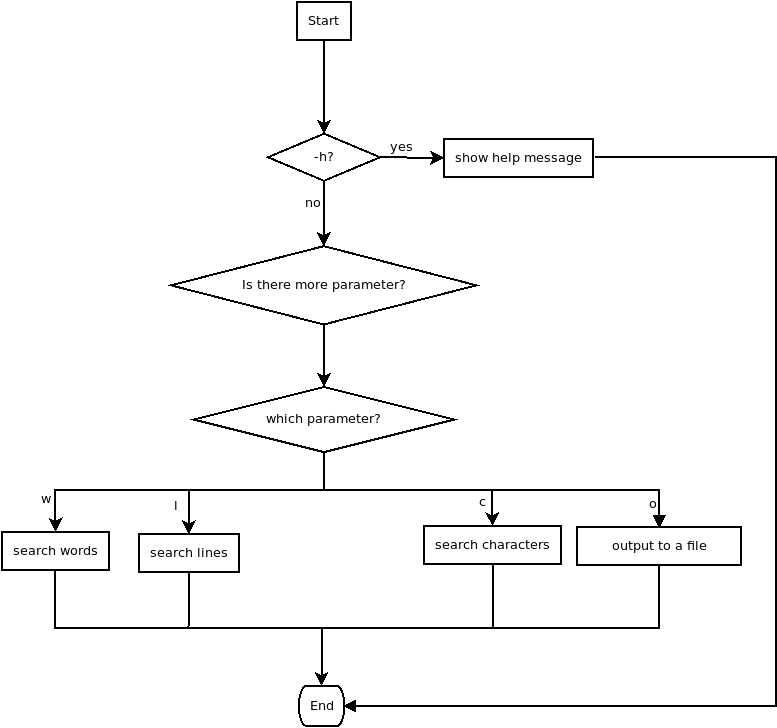标签:数据 编译 开源 pre html 用户输入 学习 file 5.5
先给出:项目地址
项目目录:
.
├── image
│ └── whole_flow_chart.png
├── readme.md
└── src
├── function.c
├── wc.c
└── wc.hwc接收一个文本文件,并统计这个文本文件中的信息(行数、字数等)
wc.exe -c file.c //返回文件 file.c 的字符数
wc.exe -w file.c //返回文件 file.c 的单词总数
wc.exe -l file.c //返回文件 file.c 的总行数
wc.exe -o outputFile.txt file.c //将结果输出到指定文件outputFile.txt
我在原来的基本上加了一个帮助选项,因为觉得这样更适用:
wc.exe -h //显示帮助信息
注意:
空格,水平制表符,换行符,均算字符。
由空格或逗号分割开的都视为单词,且不做单词的有效性校验,例如:thi#,that视为用逗号隔开的2个单词。
-c, -w, -l参数可以共用同一个输入文件,形如:wc.exe –w –c file.c 。>
-o 必须与文件名同时使用,且输出文件必须紧跟在-o参数后面,不允许单独使用-o参数
参数的形式有两种:长选项、短选项,选项间可以组合,长选项用空格隔开各个参数
例: wc.exe --word --charater file.c
短选项可以多个直接叠加或者,也像长选项一样分开写
例: wc.exe -wc file.c wc.exe -w -c file.c
对于一个命令行程序,它可以接受来自命令行的参数。
c语言的main函数中有两个参数:int main (int argc, char *argv[]),这两个参数就是用于这个参数的输入。
argc 一个整数,代表有多少个命令行参数,在此注意两个点
? 1、 参数间是用空格格开的;
? 2、程序名是第一个参数。
argv[i]是一个指针,指向第i个参数的首地址
理解了以上的两个参数就简单了,只需要做一些基本的字符串处理就可以了。
这个参数单独说是因为这个参数不能和别的参数混用,所以我在程序里面是单独写的,一开始就判断是否用户需要的是help帮助,如果是的话,那么完全不必要再运行程序(打开文件),直接exit中止进程 。
这三个参数都是一个路数:
1、打开文件;
2、判断要做的操作;
3、执行操作。
它们间只有步骤3是不同的,所以有理由把3写成不同的函数,再由2判断执行哪个。
有一些细节问题是可以考虑的。
比如,因为单复数的关系,有一行/个 单词/字母,应该是不同的表达(是否有s)
额外就是判断一个单词的算法也是值得考虑的问题,我的想法是,如果一个字符,它自己是一个字母,它前面是一个非字母,那么这就是一个单词的标致。
这个参数比较特殊,因为它后面跟了一个文件,要做的事情是把输出的内容存到的文件换成用户自定义的名字。
总的来说是两件事情

void
lines_searching(FILE *fp, bool out_to_files){
int line = 0;
int ch = 0;
while(!feof(fp)){
ch = fgetc(fp);
//putchar(ch);
if(ch == ‘\n‘) line++;
else continue;
}//of while loop
//printf("line is %d\n",line);
output_to_sdo(line, "line", out_to_files);
}//of character_searching functionvoid
words_searching(FILE *fp, bool out_to_files){
int letter =0;
int word = 0;
bool is_word = FALSE;
while(!feof(fp)){
letter = fgetc(fp);
if((letter >= ‘a‘ && letter <= ‘z‘) || (letter >= ‘A‘ && letter <= ‘Z‘ ) || (letter == ‘\‘‘)){
if(!is_word)
//if if_word is false, it means this is a brand new word
is_word = TRUE;
}//of if
else{
if(is_word){
word ++;
is_word = FALSE;
}//of if
else continue;
}//of else
}//of while loop
output_to_sdo(word, "word", out_to_files);
}//of words_searching function这个里面有一些问题要考虑:
letter != ‘\n‘ || letter != ‘\t‘ || letter != ‘ ‘void
output_to_sdo(int number, char* name, bool out_to_files){
char result_fp_name[50];//the name of the result files
char result[50];
//printf("%s\n",specific_file);
if(number == 0) sprintf(result, "No %s in the file\n", name);
else if(number == 1) sprintf(result, "1 %s in the file\n", name);
else sprintf(result, "%d %ss in the file\n",number,name);
printf("%s", result);
if(out_to_files){
strcpy(result_fp_name, specific_file);
}//of if
else{
strcpy(result_fp_name, "result.txt");
}//of else
FILE *result_fp = fopen(result_fp_name,"w");
fputs(result, result_fp);
fclose(result_fp);
}//of function output_to_fdo主要是做简单的系统测试,等价类和边界值
从输入的数据入用进行分析,本程序的输入信息就是从命令行接受的一些数据,这些个数据可以分为两人类
选项:控制程序运行的方式和输出的方式,这类选项可以分为三类
? 1.1 -h :这个选项不能和别人一用,而且这个选项不带参数,它也不允许程序再带参数;
? 1.1 -o :这个选项需要和别人组合在一起用,而且不能单用,在这个选项后面需要带一个参数,而且也需要程序带一个参数;
? 1.2 -w/-c/-l:它们都是是执行特点的查找任务的,这几个选项不带参数,但是需要程序带一个参数。
参数:在本程序中也就是需要查找的文件,分成这文件存在、不存在。
| 输入条件 | 有效等价类 | 无效等价类 |
|---|---|---|
| 选项 | -h (1)/ -w(2) / -l(3) / -c(4) / -o out(5) / -w -c(6) | -a(7) / -p(8) / -h -w(9) |
| 参数 | 文件(10) | 没有文件(11) |
I loved you.
But you didn‘t love me.
I felt sad.
But you seemed to feel happy.
So I begun to hate you.seven@mylab:~/wordcount/bin/linux_amd64$ cat result.in
Usage: wc.exe [OPTIONS]... [FILE]
--character -c calculate the numbers of characters in the file
--word -w calculate the numbers of words in the file
--line -l calculate the numbers of lines in the file
--outtofile=x -o x transfer the result to the specific fileseven@mylab:~/wordcount/bin/linux_amd64$ ./wc -h input
Wrong Parameter!seven@mylab:~/wordcount/bin/linux_amd64$ ./wc -w input
23 words in the file
seven@mylab:~/wordcount/bin/linux_amd64$ wc -w input
23 input与linux下自带的wordcount(wc)的结果对比了下
seven@mylab:~/wordcount/bin/linux_amd64$ ./wc -w nothing
Fail to Open the File!
seven@mylab:~/wordcount/bin/linux_amd64$ wc -w nothing
wc: nothing: No such file or directoryseven@mylab:~/wordcount/bin/linux_amd64$ ./wc -l input
5 lines in the file
seven@mylab:~/wordcount/bin/linux_amd64$ wc -l input
5 inputseven@mylab:~/wordcount/bin/linux_amd64$ ./wc -l nothing
Fail to Open the File!
seven@mylab:~/wordcount/bin/linux_amd64$ wc -l nothing
wc: nothing: No such file or directoryseven@mylab:~/wordcount/bin/linux_amd64$ ./wc -c input
104 characters in the file
seven@mylab:~/wordcount/bin/linux_amd64$ wc -c input
103 input出现了不同
seven@mylab:~/wordcount/bin/linux_amd64$ ./wc -c nothing
Fail to Open the File!
seven@mylab:~/wordcount/bin/linux_amd64$ wc -c nothing
wc: nothing: No such file or directoryseven@mylab:~/wordcount/bin/linux_amd64$ ./wc -w -o result.log input
23 words in the file
seven@mylab:~/wordcount/bin/linux_amd64$ cat result.log
23 words in the file
seven@mylab:~/wordcount/bin/linux_amd64$ wc -w input > result.log
seven@mylab:~/wordcount/bin/linux_amd64$ cat result.log
23 inputseven@mylab:~/wordcount/bin/linux_amd64$ ./wc -w -h
Fail to Open the File!
seven@mylab:~/wordcount/bin/linux_amd64$ ./wc -w -h nohting
Fail to Open the File!
seven@mylab:~/wordcount/bin/linux_amd64$ ./wc -w -h input
Wrong Parameter!
23 words in the file这个用例没有通过
检查用例7
seven@mylab:~/wordcount/bin/linux_amd64$ printf "I hate you\nYou hate me\n"
I hate you
You hate me
seven@mylab:~/wordcount/bin/linux_amd64$ printf "I hate you\nYou hate me\n" > my.ini
seven@mylab:~/wordcount/bin/linux_amd64$ ./wc -c my.ini
24 characters in the file
seven@mylab:~/wordcount/bin/linux_amd64$ wc -c my.ini
23 my.iniseven@mylab:~/wordcount/bin/linux_amd64$ echo "I really made a mistake??" > my.ini
seven@mylab:~/wordcount/bin/linux_amd64$ ./wc -c my.ini
27 characters in the file
seven@mylab:~/wordcount/bin/linux_amd64$ wc -c my.ini
26 my.ini三次的测试我的结果稳定的比正确结果少一个,有理由相信这是一个系统误差,是程序的错误。
查程序发现的原因,以下是代码
while(!feof(fp)){
fgetc(fp);
character ++;
}//of while loop这样把最后一个结尾字符也记上了,所以应该把结果减去1.
seven@mylab:~/wordcount/bin/linux_amd64$ ./wc -w my.ini
5 words in the file
seven@mylab:~/wordcount/bin/linux_amd64$ wc -w my.ini
5 my.ini
seven@mylab:~/wordcount/bin/linux_amd64$ ./wc -w input
23 words in the file
seven@mylab:~/wordcount/bin/linux_amd64$ wc -w input
23 input对于是否要把程序的结果输出到文件里面我选择了用一个控制变量进行操作,然后用全局的变量存储文件地址引用到函数中,似乎应该有更好的方法(我特别想看GNU的实现但是我,是在看不懂+找不到源函数)
完成一个还算比较难的程序(因为我总想着GNU写过了的wc)对一个学生而言并非易事,参考了很多(其实也不多),见下:
标签:数据 编译 开源 pre html 用户输入 学习 file 5.5
原文地址:https://www.cnblogs.com/yusaisai/p/9703612.html